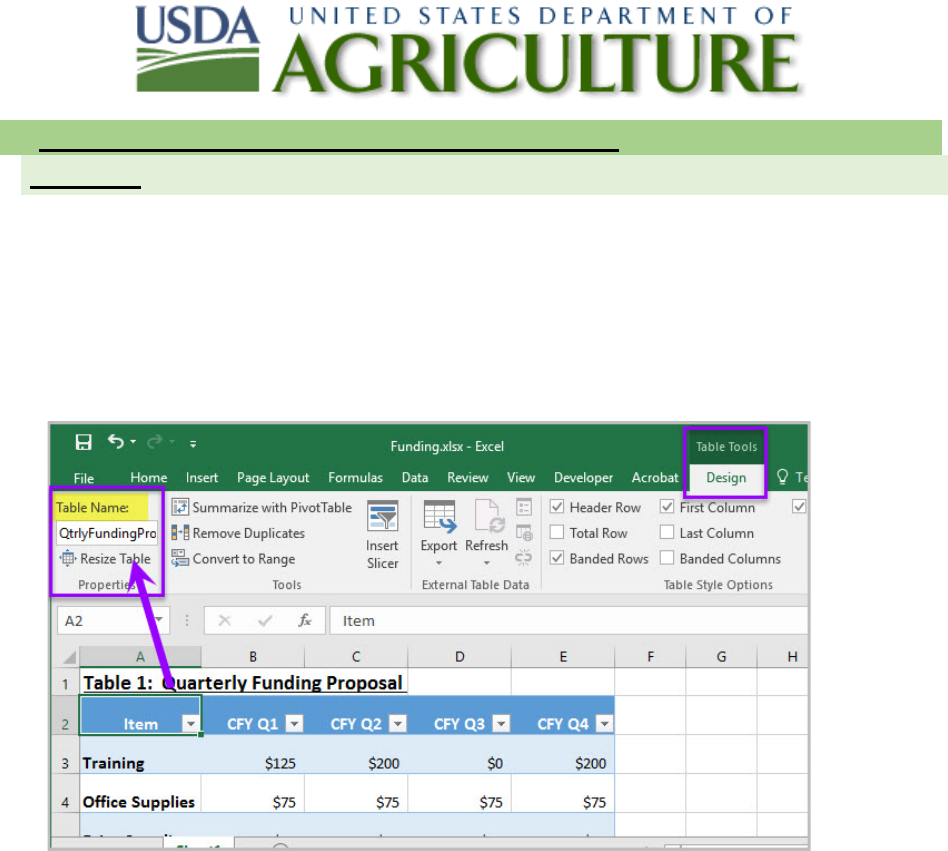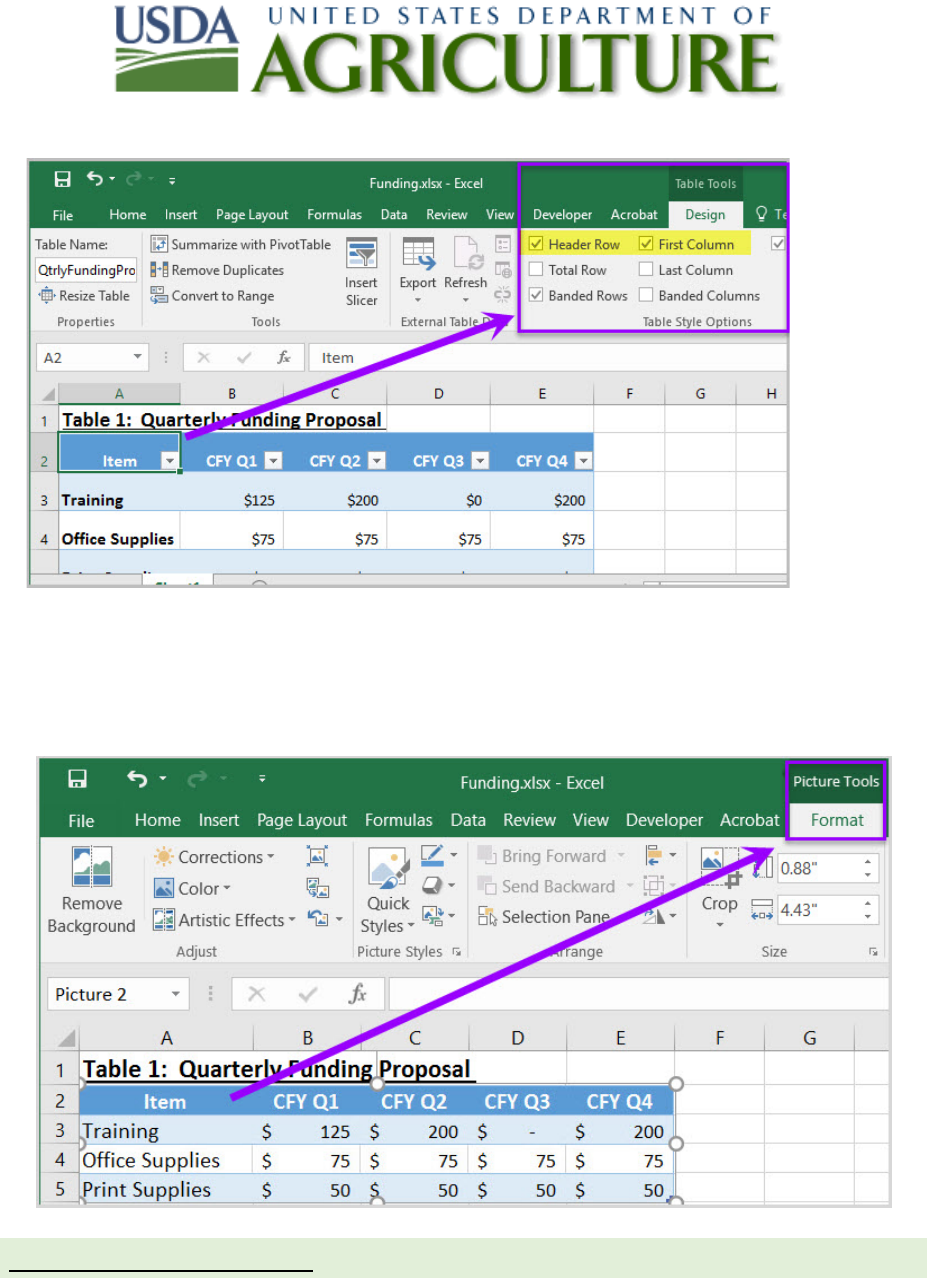
Content written and managed by the AED COP | Last Updated: August 2021
1
How to Create, Test and Remediate Spreadsheets for
Section 508 Conformance Using Microsoft Excel

Content written and managed by the AED COP | Last Updated: August 2021
2
Table of Contents
Background ..................................................................................................................................... 3
How to Read This Document .......................................................................................................... 3
AED COP Excel Checklist ............................................................................................................. 4
Document Formatting ................................................................................................................. 4
Text Formatting .......................................................................................................................... 4
Object Formatting ....................................................................................................................... 4
Color Formatting ......................................................................................................................... 5
Miscellaneous ............................................................................................................................. 5
Microsoft Excel 2016 | Basic Authoring and Testing Guide .......................................................... 6
Document Formatting ..................................................................................................................... 6
1. Is the filename descriptive and is the file in .xlsx format? .................................................. 6
Text Formatting .............................................................................................................................. 7
2. Are built-in features used to organize content? ................................................................... 7
3. Are link names descriptive? ................................................................................................. 7
Object Formatting ........................................................................................................................... 9
4. Is vital information in headers, footers, and watermarks duplicated in the worksheet? ...... 9
5. Did you use built-in features to create data tables? ........................................................... 10
6. Do images and other objects have alternative text ............................................................. 12
Color Formatting ........................................................................................................................... 14
7. Are colors and other visual characteristics that convey information (such as size, shape,
and location) also described in text? ......................................................................................... 14
8. Is the contrast ratio between text and background sufficient? ........................................... 15
Miscellaneous ............................................................................................................................... 18
9. Are descriptions of embedded audio, video and multimedia files accurate? ..................... 18
10. Did you exclude flashing objects? ................................................................................. 18
Index of Figures ............................................................................................................................ 19
Index of Tables ............................................................................................................................. 19

Content written and managed by the AED COP | Last Updated: August 2021
3
Background
The purpose of this document is to assist individuals in creating, testing, and remediating
Microsoft Excel Spreadsheets, for Section 508 conformance. The guidance provided is based
on the Section 508 Baseline Test Guide for Excel files, and the Section 508 Microsoft Excel
2016 Checklist authored by the Accessible Electronic Document Community of Practice (AED
COP). For more information on the AED COP, to download the latest AED COP guidance, and
to gain access to a detailed test process, visit the Federal Section 508 website.
How to Read This Document
This document is comprised of two sections:
1. The AED COP Microsoft Excel 2016 Checklist.
2. Instructions on how to remediate Excel files for Section 508 compliance.
For more information on how to remediate MS Excel (.xlsx) documents or to request training,
please contact your agency Section 508 Coordinator or email [email protected].

Content written and managed by the AED COP | Last Updated: August 2021
4
AED COP Excel Checklist
When creating an accessible spreadsheet, or when reviewing an Excel file for Section 508
conformance, the following conditions must be considered. The response to each criterion should
be Yes or Not Applicable to be considered accessible. If No is selected, the issue must be
resolved to be considered accessible.
For ease of use, Microsoft Excel’s Accessibility Checker is located on Microsoft’s main menu
under File > Info > Check for Issues > Check Accessibility.
Note: Due to the human-centric nature of accessibility and Section 508 conformance, content
creators must ensure individuals with disabilities are able to request additional formats and
corrections that may not be detected using automated tools, i.e., improper use of color coding.
Document Formatting
Yes
No
NA
The filename is descriptive and identifies the document or its purpose.
The file type is an Excel 2016 Workbook (.xlsx).
Yes
No
NA
The reading order matches the visual layout on each spreadsheet.
Text Formatting
Yes
No
NA
Link names are unambiguous within context and describe the
destination, function, or purpose.
Object Formatting
Yes
No
NA
Vital information is duplicated at or near the start of the related
information.
Yes
No
NA
Data tables are not pictures.
Data tables do not have merged/split cells.
Data tables do not have more than one header row/column.
Yes
No
NA
There is descriptive alternate text, descriptive text in surrounding text,
or in an appendix.

Content written and managed by the AED COP | Last Updated: August 2021
5
Color Formatting
Yes
No
NA
Text duplicates the meaning of the color or other sensory
characteristics.
Yes
No
NA
The color contrast ratio passes (WCAG Level AA).
Miscellaneous
Yes
No
NA
For audio-only, the transcript is accurate and complete.
For video-only, the text description is accurate and complete.
For multimedia, the synchronized captions and audio description are
accurate and complete.
Yes
No
NA
Forms are not enabled.
Yes
No
NA
Flashing objects are excluded.
Yes
No
NA
The information is equivalent and up to date with the primary
document.

Content written and managed by the AED COP | Last Updated: August 2021
6
Microsoft Excel 2016 | Basic Authoring and Testing Guide
This section provides detailed instructions on creating, remediating, and testing MS Excel files
(.xlsx) for accessibility.
Document Formatting
1. Is the filename descriptive and is the file in .xlsx format?
How to Test
Instruction: Look at the filename in Windows Explorer or the title bar in MS Excel. An
example of a descriptive filename is “FundingBudget.xlsx.” The file must be in the “*.xlsx”
format for accessibility testing to be possible.
NOTE: If the document extension is not displayed, open your documents folder in
Windows Explorer, select “View”>check “File name extensions.”
Figure 1: The Save As dialog window
Test A: Is the file name descriptive and does it identify the document or its purpose? If not,
the document fails this test.
Test B: Is the file in “Excel Workbook (.xlsx)” format? If not, the document fails this test.
How to author for accessibility
A descriptive file name identifying the document, or its purpose, helps everyone (including
people with disabilities) locate, open, and switch between documents. In addition, the
document must be in a “.xlsx” format because these authoring and testing instructions will
only work if the file is in the “.xlsx” file format.
• Select “File tab>Save As”
• Save as type: “Excel Workbook (*.xlsx)” with a descriptive filename.

Content written and managed by the AED COP | Last Updated: August 2021
7
Text Formatting
2. Are built-in features used to organize content?
How to test
Test A: Does each sheet have a visual and/or logical reading order, left to right then top to
bottom? If not, it fails this test.
Test B: Can the sheet be navigated using the up, down, right or left arrow keys, and does it
match the visual/logical reading order? If not, it fails this test.
How to author for accessibility
To create a worksheet with logical reading order content:
• Start all worksheets in cell A1
• Do not span content over multiple rows or columns.
Figure 2: Example of Excel Worksheet with logical reading order
3. Are link names descriptive?
How to test
Instruction: Find hyperlinks within a worksheet
Test: Do links have meaningful names that describe their destination, function, and/or
purpose OR are these determinable within context? If not, the document fails this test.
Uniquely Named Link:
www.section508.gov
Link Determinable within context:
Get My Section 508 Questions Answered
An unclear link name with no context:
click here

Content written and managed by the AED COP | Last Updated: August 2021
8
How to author for accessibility
Assistive technology users rely on meaningful names to determine the destination, function,
or purpose of links. For example, multiple “click here” links are confusing to assistive
technology users because the name for each link is the same, while the destinations may be
different.
Figure 3: Insert Hyperlink configuration window
Naming and creating links:
• To edit the name of a link, select the cell containing the hyperlink. Edit the text in
the Formula Bar.
• To create a hyperlink, select the cell for the hyperlink and either use the Hyperlink
button on the "Insert" ribbon menu or “Ctrl+K” to open the Insert Hyperlink
configuration window. Specify the Text to display and the Address for the link and
its destination.

Content written and managed by the AED COP | Last Updated: August 2021
9
Object Formatting
4. Is vital information in headers, footers, and watermarks duplicated in the
worksheet?
How to test
Instruction: Look for vital information in headers, footers, and watermarks (e.g. Respond
by X date, CONFIDENTIAL, or Do Not Distribute). Note: Watermarks in Excel are
floating objects, and cannot be made accessible.
Test: Is the vital information duplicated in the first cell of the worksheet? If not, the
document fails this test.
Figure 4: Example of vital information repeated in cell A1 of the worksheet
How to author for accessibility
Assistive technology does not automatically read information in headers, footers, and
watermarks, so you need to duplicate any vital information in cell A1.

Content written and managed by the AED COP | Last Updated: August 2021
10
5. Did you use built-in features to create data tables?
How to test
Instruction 1: Select a table (“Home>Editing>Find & Select>Go To”). Select any table
listed in the “Go To” options window. Note: Images of tables will never be listed in the “Go
To” options window.
Test A: Does a “Table Name” display under the “Table Tools>Design>Properties” group?
If not, the document fails this test
Figure 5: Table Properties group displaying Table Name
Instruction 2: Place your cursor on the first row and/or column of a table cell and see if the
worksheet has identified the header row and/or column.
Test B: Are “Header Row” and/or “First Column” in the “Table Style Options” group
checked? If not, the document fails this test.

Content written and managed by the AED COP | Last Updated: August 2021
11
Figure 6: Header Row and First Column checked in the Table Style Options group
Instruction 3: Select a table. If the Ribbon shows “Picture Tools” tab, instead of the “Table
Tools” tab, then the table is an image.
Test C: Is the worksheet free of pictures of tables? If not, the document fails this test.
Figure 7: Image of data table showing “Picture Tools>Format” tab when selected
How to author for accessibility
Assistive technology users need to be able to identify column headers in data tables to
understand the association between table cells and their respective headers.

Content written and managed by the AED COP | Last Updated: August 2021
12
To create an accessible data table you Select “Insert>Table.”
1. In the create table pane, choose the range of cells for your data table.
2. Check the “My table has headers” checkbox in the create table pane.
3. Choose any cell and name your table “Table Tools>Design>Table Name.”
4. Choose the first cell in the header column and/or row, and update the column and/or row
headings with descriptive names.
How to test
Figure 8: Image of data table showing “Picture Tools>Format” tab when selected
6. Do images and other objects have alternative text
How to test
Instruction 1: Examine cells surrounding a non-text element for text describing the object
or its purpose/meaning.
Test A: Does the image/object/shape/chart or other non-text element have descriptive text
or is there an appendix for all non-text elements? If not, the document fails this test.
How to author for accessibility
In Excel images, objects, shapes, charts and other non-text elements cannot be
anchored/embedded in a cell. Screen reader users cannot access the alt-text of floating
elements. Therefore, you must add descriptive text to images and other objects by adding

Content written and managed by the AED COP | Last Updated: August 2021
13
information in a cell near the object or list the non-text elements and their descriptions in a
separate appendix.

Content written and managed by the AED COP | Last Updated: August 2021
14
Color Formatting
7. Are colors and other visual characteristics that convey information (such as
size, shape, and location) also described in text?
How to test
Using only color or other visual characteristics to convey meaning will not provide
comparable access to people who are blind, have low vision, or are colorblind.
Instruction: Find where you have used color and/or other visual characteristics to convey
meaning such as green, yellow, red, etc.
Test: Is there text that conveys the meaning of the color or other visual characteristics? If
not, the document fails this test.
How to author for accessibility
The following layout tables describe the progress for three projects using colors to
symbolize the current project status. Adding text in addition to the color provides
comparable information to users of assistive technology and people who are colorblind.
Use text to duplicate the meaning of the color or visual characteristics (such as size, shape,
and location).
Table 1: Examples of a project status table using only color and color with text
Project Status
Project A
Project B
Project C
Project Status
Project A On Time
Project B At Risk
Project C Late

Content written and managed by the AED COP | Last Updated: August 2021
15
8. Is the contrast ratio between text and background sufficient?
NOTE: If the document text is black on white background (or close to it), you do not need
to perform this test. This test requires the Colour Contrast Analyzer (an external
application).
How to test
Execute the Colour Contrast Analyzer. Select “Download” (the application can be executed
without downloading it onto your computer). Open the Colour Contrast Analyzer. Drag the
“Foreground eyedropper” icon over a sample of your text or image of text. Drag the
“Background eyedropper” icon over a sample of your background color.
Test: Have you formatted with the correct color contrast ratio? If not, the document fails
this test.
Figure 9: Examples of pass and fail results with the Colour Contrast Analyzer

Content written and managed by the AED COP | Last Updated: August 2021
16

Content written and managed by the AED COP | Last Updated: August 2021
17
How to author for accessibility
People who are colorblind or have low vision will have comparable access if there is
sufficient contrast between the text and the background. The contrast standards are:
Table 2: Table with contrast ratios for types and sizes of text
Type or Size of Text
Contrast Ratio
Standard text (12 pt regular) 4.5:1
Large Text (14 pt bold or 18 pt regular)
3:1
Incidental text, text overlaid on images, and logotypes Excluded from requirement
Create content with text or images of text that use color or shading with sufficient color
contrast. If the contrast ratio does not pass, then adjust your foreground or background until
it does pass.
Table 3: Examples of good and insufficient color contrast ratios
Good Color Contrast Insufficient Color Contrast
White text on
black background
ratio 21:0:1
Dark gray text on
black background
ratio 3.0:1
Dark green text
on yellow background
ratio 7.6:1
Orange text on
yellow background
ratio: 2.1:1
Light blue text on
dark blue background
ratio: 10.5:1
Red text on
dark blue background
ratio: 1.1:1
white text on
red background
ratio: 6.5:1
Dark green text on
red background
ratio: 1.3:1

Content written and managed by the AED COP | Last Updated: August 2021
18
Miscellaneous
9. Are descriptions of embedded audio, video and multimedia files accurate?
How to test
NOTE: If the document does not contain audio, video, or multimedia files, you do not need
to perform this test.
Instruction: Activate the audio-only, video-only, or multimedia file.
Test A: Is there an accurate and complete text transcript for multimedia files, text
description for audio files, and synchronized caption and/or audio description for video
files? If not, the document fails this test.
How to author for accessibility
If you embed an audio-only, video-only, or multimedia file that contains meaningful
information into your MS Excel Workbook, you must also provide additional information so
that individuals with disabilities have comparable access to the information.
• Audio-only
o Accurate and complete transcript
• Video-only
o Accurate and complete text description
• Multimedia (audio and video)
o Accurate and complete synchronized captions and audio descriptions
10. Did you exclude flashing objects?
How to test
Test: Is the document free of all flashing objects? If not, the document fails this test.
How to author for accessibility
Create your content without using flashing objects. Flashing objects can cause seizures and
should never be used.

Content written and managed by the AED COP | Last Updated: August 2021
19
Index of Figures
Figure 1: The Save As dialog window ................................................................................... 6
Figure 2: Example of Excel Worksheet with logical reading order ........................................... 7
Figure 3: Insert Hyperlink configuration window ................................................................... 8
Figure 4: Example of vital information repeated in cell A1 of the worksheet ............................ 9
Figure 5: Table Properties group displaying Table Name ....................................................... 10
Figure 6: Header Row and First Column checked in the Table Style Options group ................. 11
Figure 7: Image of data table showing “Picture Tools>Format” tab when selected .................. 11
Figure 8: Image of data table showing “Picture Tools>Format” tab when selected .................. 12
Figure 9: Examples of pass and fail results with the Colour Contrast Analyser ........................ 15
Index of Tables
Table 1: Examples of a project status table using only color and color with text ..................... 14
Table 2: Table with contrast ratios for types and sizes of text ............................................... 17
Table 3: Examples of good and insufficient color contrast ratios ............................................ 17
